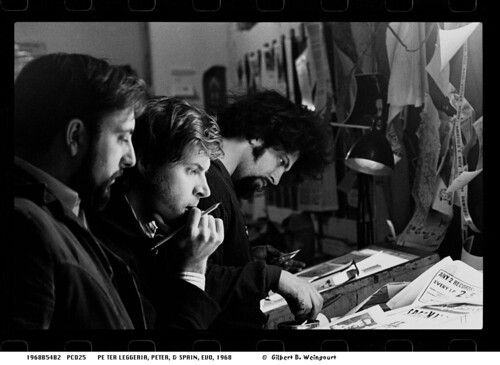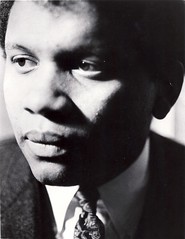Earlier this week, the Arthur L. Carter Journalism Institute launched “Blowing Minds: The East Village Other, the Rise of Underground Comix and the Alternative Press, 1965-72,” with a rousing discussion that’s now archived on the exhibit’s Website, along with new audio interviews with veterans of the Other. Over the course of seven weekend editions of The Local, we’ve heard from all but one of the EVO alumni who spoke on Tuesday’s panel. Here now, to cap off our special series, is the story of Peter Leggieri.
 Gil Weingourt Left to right: Peter Leggieri, Peter Mikalajunas, and Spain Rodriguez.
Gil Weingourt Left to right: Peter Leggieri, Peter Mikalajunas, and Spain Rodriguez.From the first day that I began working at The East Village Other, I was overcome by the sense that it was not only a newspaper but a strange and magical ship on a voyage with destiny. It seemed as though each issue printed was a new port of call, and the trip from one issue to the next, a new adventure. Many of EVO’s crew members expressed that same weird feeling – a sense of excitement and creative power.
And what a crew that was! No one was recruited. I don’t recall a resume ever being submitted. They all simply showed up and started working. EVO’s crew might just have been the greatest walk-on, pick-up team in the history of journalism. She was The Other but her staff of artists, poets, writers, photographers and musicians affectionately called her EVO. Her masthead bore a Mona Lisa eye. EVO created a cultural revolution and won the hearts and minds of a generation. She was the fastest ship in the Gutenberg Galaxy.
In the Beginning
I was the anonymous Other, the one editor-owner unknown to the public. I did not party. I did not schmooze with the literati or seek publicity. I had no time for such things. I worked seven days a week, 20 hours a day and, because of law school, I had to be sober. My friend, the poet John Godfrey, told me that I was afflicted with a Zen curse: a hermit condemned to be surrounded by people and events. That was certainly the case for me in the 1960s. Read more…
In Larry “Ratso” Sloman’s 1998 book, “Steal This Dream: Abbie Hoffman and the Counter-Culture Revolution in America,” he recounts what happened the day Abbie Hoffman dragged him and Peter Leggieri out of the East Village Other office to witness the Yippie icon’s attack on Wall Street. Mr. Sloman was a lowly EVO intern at the time who credits the paper with giving him his start as a writer. The excerpt is reprinted here with the author’s permission.
Read more…
Last weekend, in one of our posts celebrating The East Village Other, Ed Sanders wrote that poet Ted Berrigan may have named the alternative newspaper after the Rimbaud line “I is an Other.” Mr. Sanders acknowledged, “Another account has Ishmael Reed coining the name.” In the comments, EVO editor Peter Leggieri wrote that Allen Katzman (who founded the paper along with Dan Rattiner and Walter Bowart) “always gave the impression that he had suggested the name ‘Other.'” After citing the reasons, Mr. Leggieri wrote, “However, if the question of origin came to a vote, I’d probably pull the lever for Ishmael Reed.” Here, now, is Mr. Reed himself, on his role in shaping The East Village Other.
 Isamu Kawai Ishmael Reed, 1967
Isamu Kawai Ishmael Reed, 1967My receiving a job as the editor of a newspaper in Newark, N.J., led to the origin of The East Village Other. I worked a number of temporary jobs from the time I arrived in New York in the fall of 1962 until I left for California in the summer of 1967. One of those jobs was that of a pollster for The Daily News. So when I went to the Department of Labor to get a temporary job, after the poll was completed, I was informed of an opening for a reporter for a new newspaper in Newark.
I had written for a newspaper in Buffalo called The Empire Star, edited by the great A.J. Smitherman, who was the target of mob violence during one of the worst riots in American history, the Tulsa riots of 1921, which left 300 blacks dead.
Smitherman believed in armed self-defense against lynching. After an interview with the investors, it was decided that I would be the editor of a newspaper that I named Advance. Although I had watched the production of a newspaper using the old linotype method while working for the newspaper in Buffalo, I hadn’t a clue about offset printing.
Walter Bowart was a bartender at Stanley’s, which was our hangout. It was owned by Stanley Tolkin who was a patron of the arts and our benefactor. Read more…






